Bhindi ki sabji is a simple, easy, and tasty vegan recipe of a mildly spiced dry okra curry that tastes delish with some Indian breads like roti or phulka. Bhindi sabzi also makes for a comforting meal with dal and rice – a perfect Indian meal accompanied by some mango pickle or raita or salad.
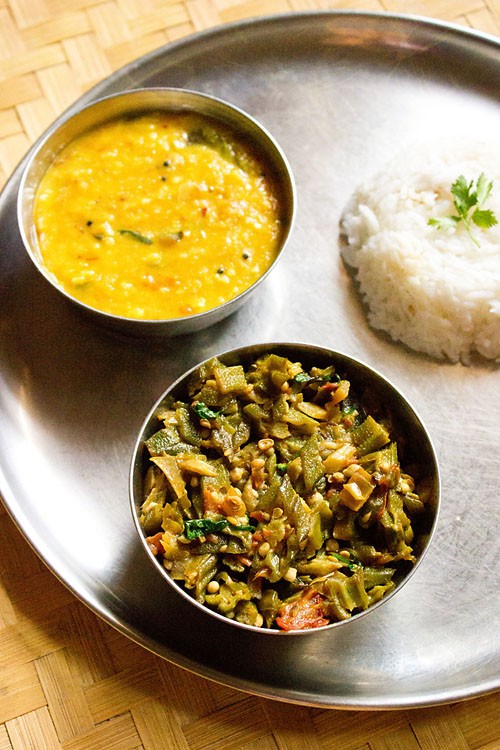
About Bhindi ki Sabji Recipe
This is one of my mom’s excellent recipe for making bhindi ki sabji. It is relatively easy to prepare and tastes also good.
Okra is called ‘bhindi’ in Hindi and ‘bhendi’ in Marathi or Konkani languages. ‘Sabji‘ in Hindi or ‘bhaji‘ in Marathi means any vegetable or a dish made with any veggie.
Okra is a favorite with many folks and in India, we have so many recipes made with these bright, green, shiny pods. I have also shared another simple recipe of Goan style Bhendi Chi Bhaji.
In this bhindi ki sabji recipe, there is a special spice added that brings in a subtle flavor and aroma to the dish – they are powdered fennel seeds also known as saunf powder in Hindi.
Now if you do not have any fennel seeds powder, then do not add it. Your bhindi sabzi will still taste good.
The base of the recipe is sautéed onions, tomatoes with aromatic ground spices and not pungent ground spices. In our bhindi sabji recipe, we do not add ginger, garlic, and red chili powder.
To give faint heat notes, green chillies are added. You can skip adding these if you have very small kids or you are intolerant to spice.
How to make Bhindi ki Sabji
Before you begin making bhindi sabzi, you have to prep the okra, chop and then start with making bhindi sabzi.
Preparation
1. Rinse 250 grams bhindi (okra) well with water. Drain all the water.
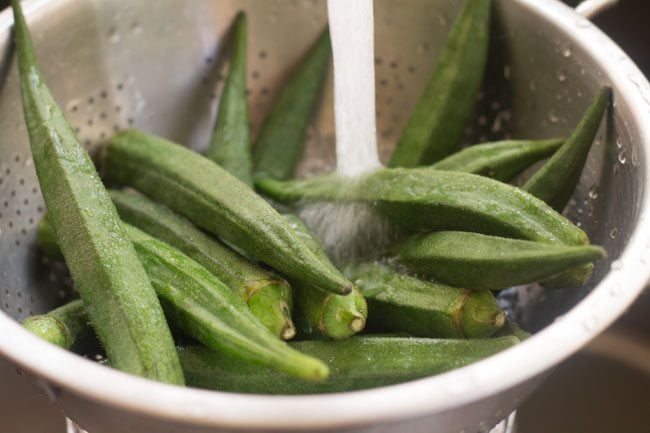
2. Dry each bhindi with a kitchen napkin. You do not get a slimy or mushy bhindi if you wipe dry the okra very well. If you have time, you can even spread the rinsed okra on a tray or plate and let them dry naturally.
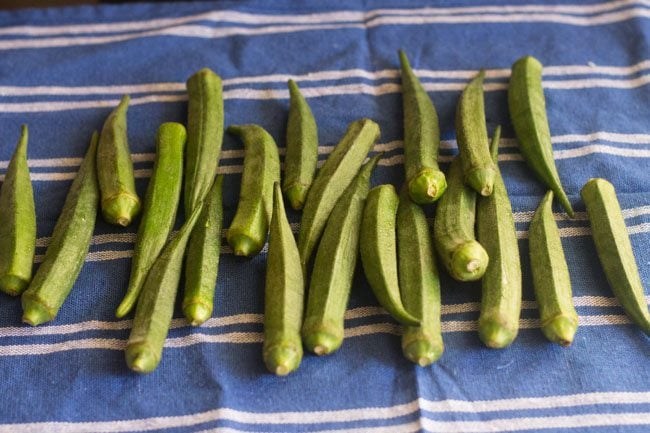
3. Slice and discard the stalks and the lower tip from the okra pods.
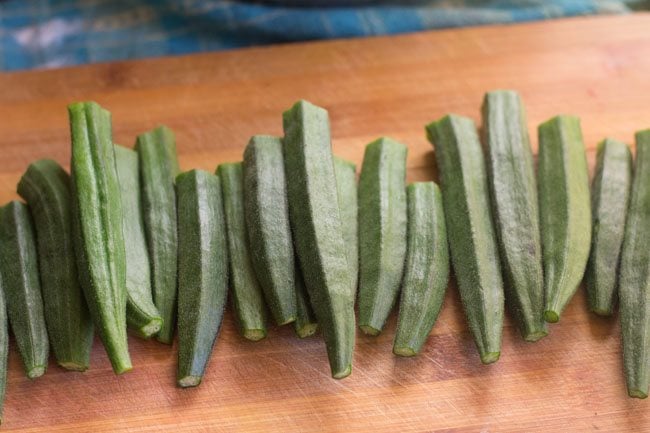
4. Chop the bhindi into round pieces of ½ to 1 inch.
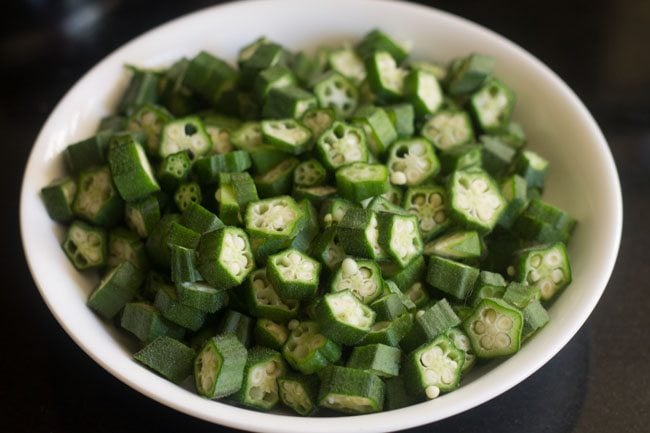
Sautéing
You begin by first sautéing the onions, then the tomatoes and the ground spices. Make sure to keep all the ground spices ready with you as you add them one by one to the dish.
5. Heat 2 tablespoons oil in pan or wok. Add ¾ to 1 cup chopped onions (about 1 large onion). For the oil, you can add sunflower oil, peanut oil or any neutral oil.
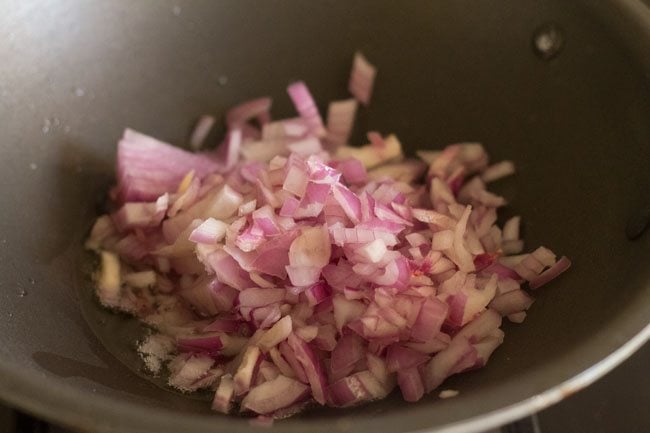
6. Stir and mix the onions.
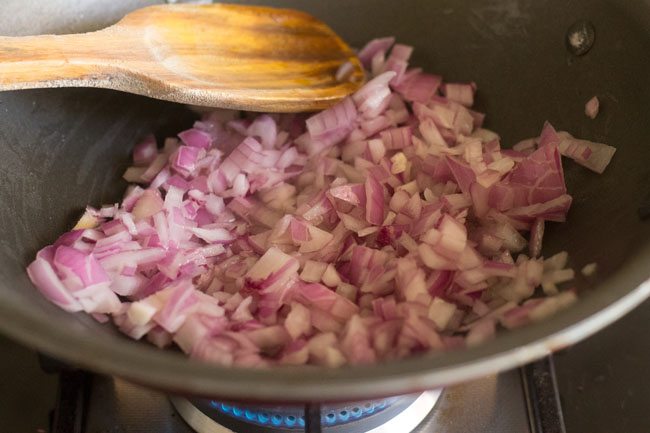
7. Sauté the onions until they soften on a low to medium-low heat.
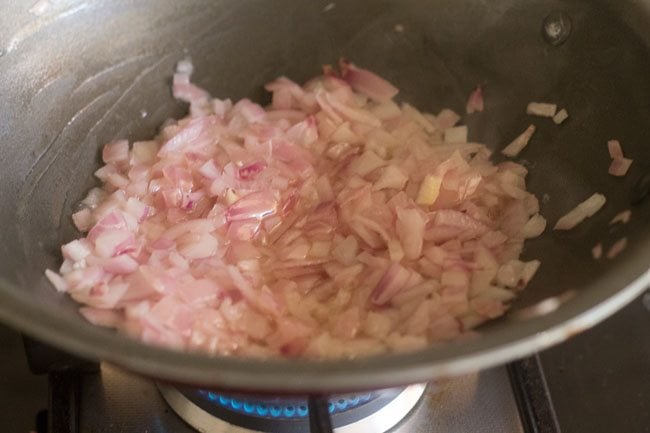
8. Now add 1 teaspoon chopped green chillies (1 green chili) and ¾ to 1 cup chopped tomatoes (1 large tomato).
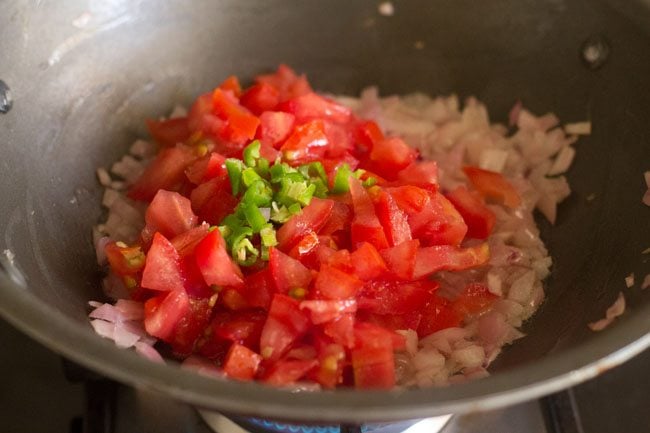
9. Mix well and sauté for a couple of minutes until the tomatoes soften and become pulpy.
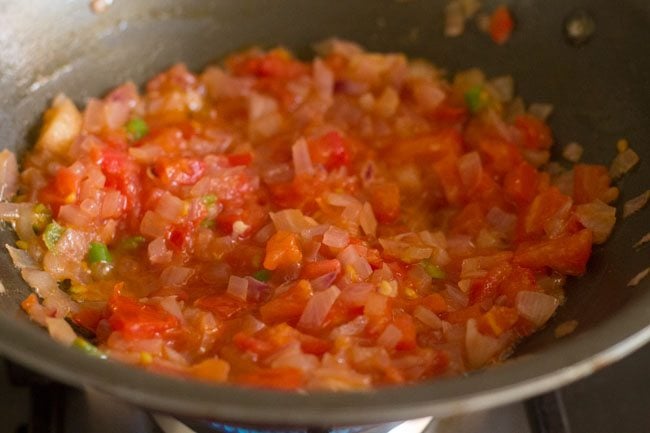
10. Add 1 teaspoon fennel powder, 1 teaspoon coriander powder, ½ teaspoon turmeric powder, 1 pinch of asafoetida (hing), a pinch or two of dry mango powder (amchur powder) and ¼ teaspoon garam masala powder.
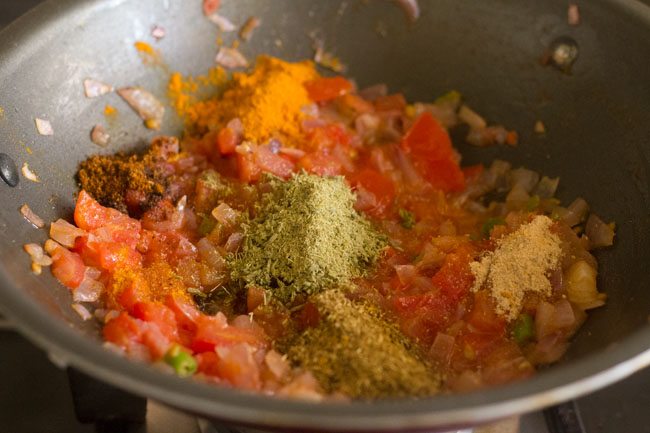
11. Mix well and sauté for a minute.
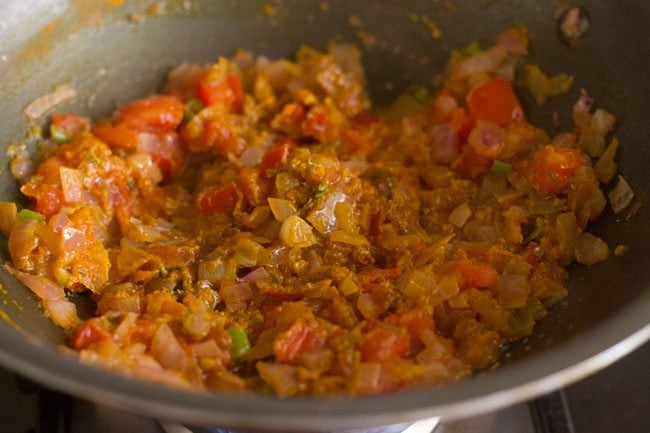
Making Bhindi ki Sabji
12. Then add the chopped okra.
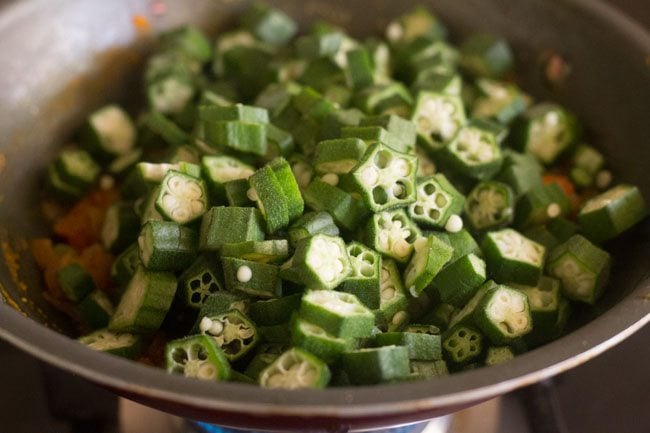
13. Mix well and then add salt as required. Gently mix again.
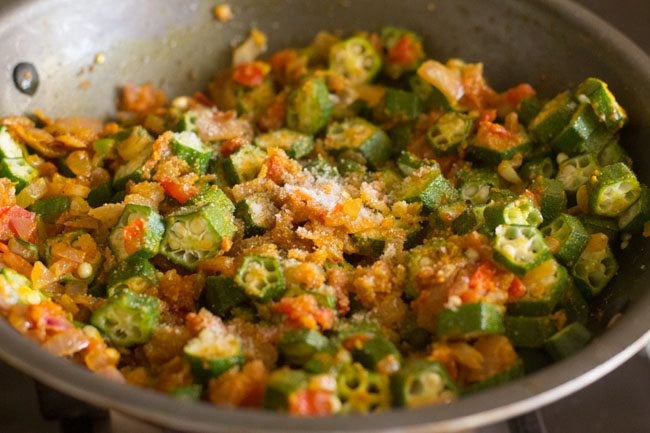
14. Place a lid with a rim on the pan or kadai. Pour some water on the lid. You see here that in this technique we are not adding any water to the bhindi. This would make them mushy and slimy.
The water added on top of the lid helps to create steam inside the pan which helps in cooking the bhindi. This method saves a lot of time and there is less chance of the bhindi or the other ingredients sticking to the pan.
Nevertheless, you have to check after every few minutes, in case the bhindi sabzi starts sticking to the pan.
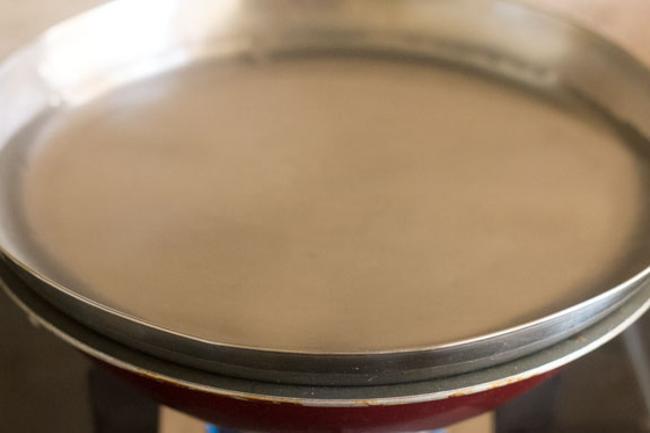
15. Cook the okra until they are tender on a low to medium heat. Keep on checking in between and stir occasionally, so as to avoid the bhindi bhaji sticking to the bottom of the pan.
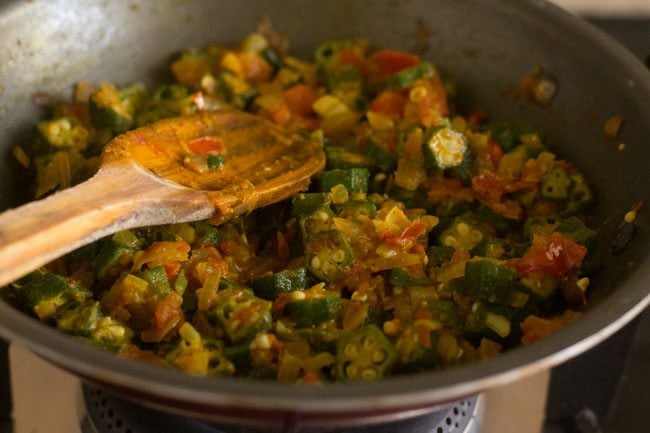
16. When the okra is tender and softened, garnish with 1 to 2 tablespoons chopped coriander leaves.
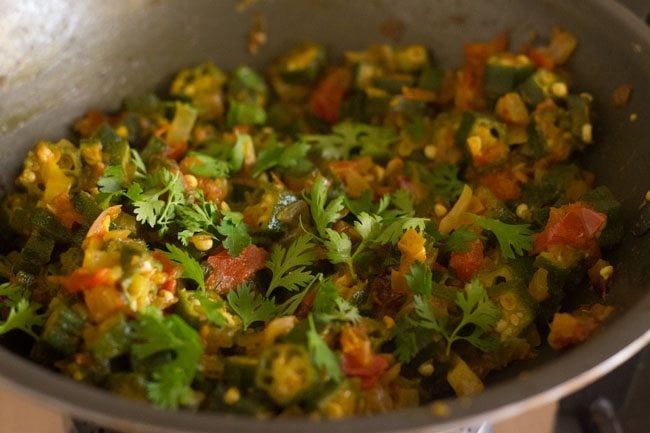
17. Serve Bhindi ki sabji hot or warm.
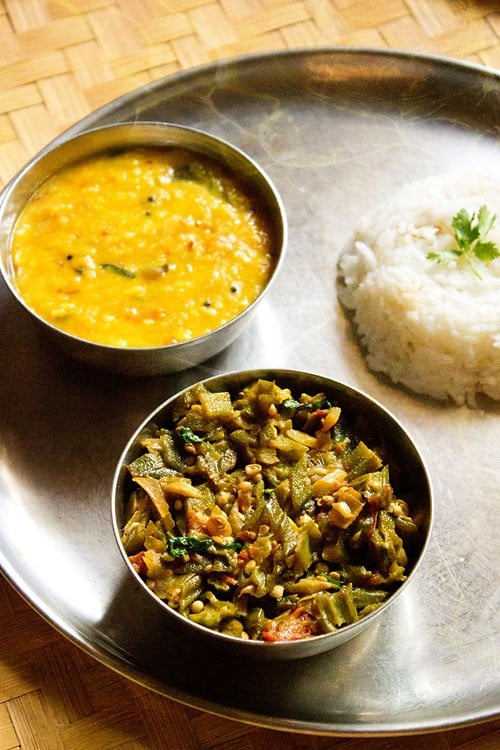
Serving Suggestions
Bhindi ki sabji is best had with Indian flatbreads – roti, paratha, or naan. As a side veggie dish, it also tastes great with dal and rice or kadhi-rice and makes for a complete meal.
Bhindi bhaji can also be packed in the lunchbox with some roti, paratha, or bread.
Expert Tips
- Choosing okra: Buy okra pods that are tender, young, and fresh. Aged okra does not have that shiny green color and may have dark spots or marks on them. They will also be highly stringy.
- Chopping bhindi: When chopping bhindi, make sure they are completely dry and do not even have a drop of water or moisture on them. While cutting bhindi, you will see some of the sticky substance on the knife. Simply wipe it with a paper kitchen towel.
- Cooking non-sticky okra: There are many ways okra recipes are made in Indian cuisine. A tried and tested method is to add sour ingredients like tomatoes, tamarind, yogurt, vinegar, lemon juice, etc. The acidity from these ingredients helps in making the okra non-sticky and non-slimy. In my recipe, we achieve this by adding tomatoes and dry mango powder.
- Scaling: You can double or triple the recipe easily.
- Spicing: This bhindi ki sabji is mild and not spicy or pungent. For a spicy taste, you can add some red chili powder, ginger-garlic paste and increase the number of green chilies.
- Gluten-free version: To make a gluten-free bhindi sabzi, simply skip asafetida (hing) or add gluten-free asafetida.
- Cooking in Instant pot: I never cook dry or semi-dry okra recipes in the Instant pot. It is best to use a frying pan, skillet, or kadai (Indian wok) to make recipes like this one. Making this bhindi ki sabji in the instant pot will make it mushy and slimy as water will be added.
FAQs
Firstly, dry the okra completely before you chop them. Use an acidic sour food ingredient (mentioned in the tips section above) in your recipe. Try not to cut the okra finely. Sautéing, pan-frying, or deep frying okra also helps in reducing the sliminess.
Okra does not take plenty of time to be cooked. If the okra pods are fresh and tender, they cook very fast – about 6 to 8 minutes. If they are slightly mature, they will take a couple of more minutes to cook.
No, never wash or rinse bhindi after cutting. When fresh chopped bhindi comes in touch with water, you are headed to get a really gooey, slimy, and sticky bhindi.
When you keep okra for many days in the refrigerator, they turn black and are not edible. Do keep them in a moisture-free dry cotton bag (which is what I do) and use them in 1 to 2 days. Do not keep for a longer time.
No – okra is never peeled.
First, use a good quality heavy pan when sautéing or pan-frying bhindi. Next do not overcook the bhindi. Just cook them till their crunch is not felt and they have beautifully softened. I have read and heard about adding baking soda to preserve the green color on the veggies, but I do not follow such practices in my everyday cooking.
More Delicious Bhindi Recipes
Okra Recipes
Okra Recipes
Okra Recipes
Okra Recipes
Please be sure to rate the recipe in the recipe card or leave a comment below if you have made it. For more vegetarian inspirations, Sign Up for my emails or follow me on Instagram, Youtube, Facebook, Pinterest or Twitter.
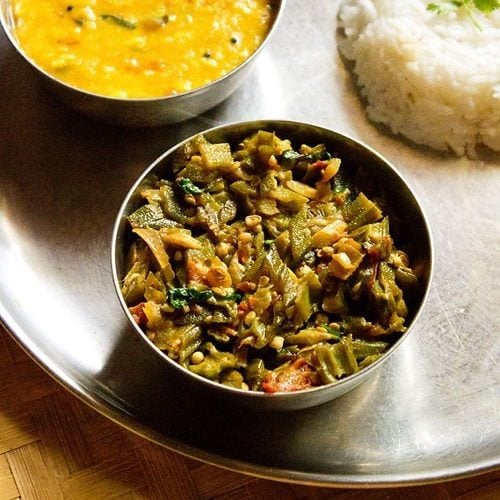
Bhindi ki Sabji (Punjabi Style Bhindi Sabzi)
Ingredients
- 2 tablespoons oil
- ¾ to 1 cup chopped onions or 1 large onion
- ¾ to 1 cup chopped tomatoes or 1 large tomato
- 250 grams bhindi (okra or lady finger)
- 1 teaspoon chopped green chilies or serrano pepper or 1 green chilli
- 1 teaspoon fennel powder (ground fennel)
- 1 teaspoon Coriander Powder (ground coriander)
- ½ teaspoon turmeric powder (ground turmeric)
- 1 pinch asafetida (hing)
- 1 to 2 pinches dry mango powder (amchur)
- ¼ teaspoon Garam Masala
- salt as required
- 1 to 2 tablespoons chopped coriander leaves (cilantro)
Instructions
Preparation
- Rinse okra well with water. Dry each okra with a kitchen napkin.
- Trim the top stalk part and base tip part. Then chop the okra into ½ to 1 inch round pieces.
Sautéing
- Heat oil in pan or kadai. Sauté the onions until transparent.
- Now add the green chili and tomatoes. Sauté them until the tomatoes soften.
- Add all the spice powders one by one.
Making bhindi ki sabji
- Mix and sauté for a minute. Then add chopped okra. Mix well. Add salt as required and mix again.
- Place a lid with a rim on the pan or kadai. Pour some water on the lid.
- On a low to medium heat, cook the okra until they are softened.
- Keep on checking in between and stir occasionally to avoid the bhindi sabzi from sticking to the pan.
- When the okra is tender and softened, garnish the bhindi bhaji with chopped coriander leaves.
Serving suggestions
- Serve bhindi ki sabji hot with roti or paratha. You can also serve it as a side dish with dal and rice or kadhi and rice. Bhindi sabzi can also be packed in the lunch-box with a side of roti, paratha or bread.
Notes
- Buying okra: Get okra pods which are tender, young and fresh. Aged or mature okra will be highly stringy.
- Chopping bhindi: When chopping okra, make sure they are completely dry and do not even have a drop of water or moisture on them. While cutting bhindi, you will see some of the sticky substance on the knife. Simply wipe it with a paper kitchen towel.
- Cooking non-sticky okra: Adding sour acidic ingredients like tomatoes, tamarind, yogurt, vinegar, lemon juice help in making the okra non-sticky and non-slimy.
- Scaling: You can double or triple the recipe easily.
- Spicing: This bhindi sabzi recipe is mild and not spicy or pungent. For a spicy taste, you can add some red chilli powder, ginger-garlic paste or increase the number of green chillies.
- Gluten-free version: To make a gluten-free bhindi bhaji, simply skip asafetida (hing) or add gluten-free asafetida.
Nutrition Info (Approximate Values)
This Bhindi ki Sabji recipe from the archives was first published in Oct 2012. It has been updated on November 2024.
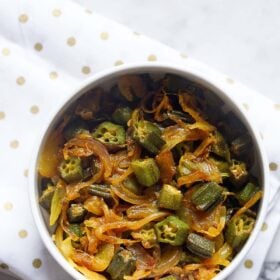
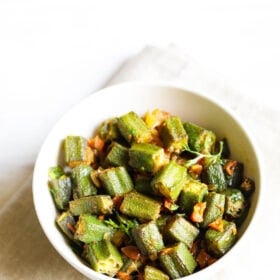
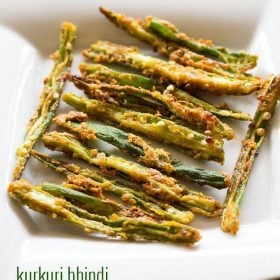
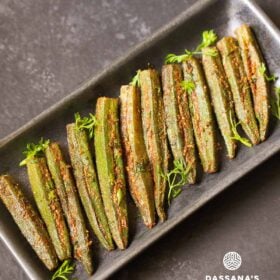
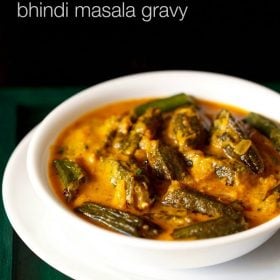
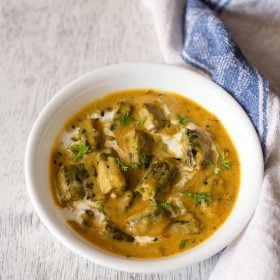








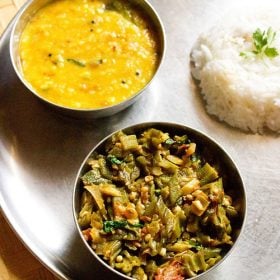
Tried this bhindi recipe. Had never put tomato in bhindi. It turned out super good. Addition of fennel(though I put seeds directly some I forgot to powder them) added a complete new dimension to the taste. Loved it. Thanks.
Hi,i tried ur recipe n it turned out so delicious & tsty…thanx a lot
Welcome Fara
Recepie are interesting
sure juliana we would keep posting new recipes.
bahut badiya kya khna
I just followed this recipe (with some variation, just due to not having stuff) and it’s awesome. I love bhindi, and I’ve wanted to try making bhindi bhaji for quite a while – I should have done sooner, didn’t realise it would be so straightforward!
Thanks to Bee for the tamarind to substitute amchoor powder – I even further removed by using tamarind sauce rather than pure extract which I couldn’t find (I gave up after *ages* looking and was more than happy to find a sauce that at least had it as main ingredient..!)
I also substituted garam masala powder for extra coriander and some cumin – since I looked up a GM recipe and they were the majority ingredients, so I figured at a 1/4 teaspoon the difference would be negligible.
Really happy with the results, tasted great and I have some left for another couple of days 🙂
I was unsure however what is meant by “cover with lid and pour some water on it” – I don’t think the water is meant to be added to the mix? Is this just to cool the lid, and so aid in the condensation of evaporated water that was already in the pan? I wasn’t sure, so I just used a ceramic plate, and didn’t pour water over.
I already look forward to using this recipe again! 🙂
thanks ollie for this feedback. i am glad to know that the substitutions worked well in the recipe. if there is no garam masala, than what you did makes sense. an extra coriander and cumin powder always work. i also use this trick and also i crush some cinnamon, cloves and cardamom, when i run out of garam masala.
i use a lid with a rim and pour water on the lid. the water does not go into the bhindi. its helps in condensation inside the pan and the veggies cook in steam. you can cover also with a tight lid. but usually for most such recipes, i use this method. thereby i don’t need to add any water inside the pan.
I have made it thrice now. Love it!
Thanks for the recipe 🙂
thanks greeshma
Just cooked this tonight, substituting tamarind paste for the amchoor powder (which I don’t have in stock), and it was AMAZINGLY yummy. I’m afraid I fried it off in ghee rather than oil, however! SUPER recipe, thank you! x
thats the ghee doing the work. glad to know that the recipe was SUPER.
Where can I find the stone mortar-pestle in the picture you’ve posted above?
hi diana. the stone and mortar pestle is from kerala – an indian state in the south. i am not sure where else you would be able to get them.
cn u plz tel me a substitute for dry mango powder?.. i hvnt come across it till nw.
any souring ingredient can be used instead of dry mango powder. the taste won’t be same but there will be sourness in the food. the final dish will have the taste and flavor of the souring ingredient you have used. it also depends on the recipe in which the sour ingredient can be used. in this recipe for example, you can add some lemon juice. for making chana or chole recipe, you can add dry pomegranate powder/anardana powder or tamarind paste or even lemon juice instead of mango powder. in dals, lemon juice or kokum can be added.
Different Bindi Bhaji will definitely try.
sure roopa, do try.
that looks so yumm 🙂
Hi Dassana,
Made this for dinner today. Came out quite tasty. thanks.
thanks and welcome ashwini 🙂
Hi Dassana,
Just had a question why didn’t you fry the bhindi before to take out the “lais” the gooey stuff which comes out from the bhindi. Whenever I make bhindi which I have learned from my mother and aunts they always fry the bhindi first till light brown, take it out and then make all the masala first and then add bhindi.
dear huma, there are two ways of making bhindi. one is lightly sauting or frying so that the “lais” or the mucilage is got rid of. and the other is cooking directly with the masala or spices. in the second method, to reduce the sliminess sour ingredients like tomatoes, amchur, tamarind paste, curd, lemon juice or kokum are added. in this recipe i have used tomatoes and very little amchur powder, just for the taste. so when cooking you will see the sliminess but once the dish is cooked, there is no sliminess.
at times i make okra just with some jeera, curry leaves, ginger, onions and kokum. then i add some coconut from top. in this recipe also there is no sliminess.
after washing, if we dry the okra well with a kitchen napkin, then also the sliminess gets reduced.
Thanx for the information. I will try bhindi this way.
welcome huma 🙂
Sounds good and comforting plate of meals that is 🙂